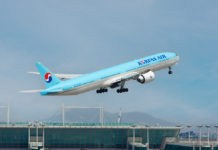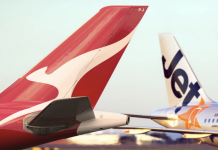Crosswind take-offs can be as spectacular and nerve-racking as crosswind landings and can certainly test passenger’s stomachs.
Intense winter storm Emma which hit the UK in early March resulted in some testing times for pilots and passengers.
This video taken by flugsnug was shot at Birmingham Airport .
Typically, aircraft land and take-off into the wind to decrease the landing or take-off distance.
In some cases, aircraft land or take-off with a slight down-wind component – typically associated with noise sensitive airports where one runway is preferred over another.
Where a pilot faces a crosswind landing or take-off they need to point the aircraft in the direction of the wind while maintaining a straight course toward the runway or on the runway.
This is called crabbing or yawing.
WATCH: Emirates A380 snowy blast
In strong crosswinds, the pilot may also dip the wing – sideslip – into the direction of the wind for the landing.
Just before touch down pilots apply rudder to bring the plane – and its undercarriage – back so it is aligned straight down the centerline of the runway.
This takes great skill and the results –if not done properly – are often quite spectacular as shown in the video.
But for a take-off, the pilot flying needs to be ready to kick in the rudder once airborne to keep the plane on its course.























